Binary Neutron Star (BNS) Merger: What We Learned from Relativistic Ejecta of GW/GRB 170817A
Abstract
1. Introduction
- The prompt gamma-ray was intrinsically faint and somehow softer than any other short GRB with known redshift;
- It was finally detected at ∼ days [16], but surprisingly rather than fainting, its flux increased and peaked at ∼ days;
- The same behaviour was observed in radio bands;
2. Review of Multi-Probe, Multi-Wavelength Observations of GW/GRB 170817A
2.1. Gravitational Waves (GW)
2.2. Prompt Gamma-Ray
2.3. X-ray Afterglow
2.4. Optical/IR Afterglow
2.5. Radio Afterglow
2.6. Comparison with Other Short GRB-Kilonova Events
3. Analysis and Modeling of GW/GRB 170817A Data
3.1. Phenomenological Formulation of Relativistic Shocks and Synchrotron/Self-Compton Emission
3.2. Prompt Emission
3.3. Late Afterglows
3.3.1. Shortcomings of a Mildly Relativistic Outflow
3.3.2. Multi-Component Models
3.3.3. Degeneracies
3.4. Other Models and Their Consistency with Data
4. Interpretation of Models
4.1. Selecting between Prompt Models
4.2. Kinematic of the Jet at Late Times
4.2.1. Late Time Jet Structure and Interpretation of Components
4.2.2. Delayed Brightening
5. Properties of GW/GRB 170817 Progenitors and Their Environment
5.1. Equation of State, Magnetic Field and Spin
5.2. Environment of Progenitor BNS
6. Outline and Prospectives for Future
- -
- Absence of bright short GRBs at low redshift is probably a signature of population evolution;
- -
- Absence of extended gamma-ray or X-ray emission from lateral expansion of the jet during internal shocks, which had to bring additional material to the line of sight.
- -
- Due to degeneracies, a core Lorentz factor as small as ∼250–300 cannot be ruled out. This is much smaller than what is predicted for typical short GRBs.
- -
- Simulations show that the properties of circum-burst material, notably its distance from center, rather than those of the jet are responsible for the late brightening of afterglows.
- -
- Progenitors were old and thereby cool neutron stars with close masses;
- -
- They had soft equations of state and small initial magnetic fields of ≲ G. Their fields were probably anti-aligned with respect to orbital rotation axis and each other.
- -
- The merger produced a HMNS with a moderate magnetic field of ≲– G.
- -
- The HMNS eventually collapsed to a black hole and created a moderately magnetized disk/torus and a low density, low magnetized outflow.
- -
- A total amount of ∼0.03–0.05 material, including – of tidally stripped pre-merger and a post-merger wind were ejected to high latitudes. They were subsequently collimated and accelerated by transfer of Poynting to kinetic energy. The same process increased electron yield by segregation of charged particles.
- -
- A small mass fraction of the polar ejecta was accelerated to ultra-relativistic velocities and made a relatively weak GRB. The reason for low Lorentz factor, density, and extent of this component was the weakness of the magnetic field.
- -
- For the same reasons, the ultra-relativistic section of the jet was narrow and our off-axis view of ∼ was enough to reduce the emission of high energy photons in our direction.
- -
- After prompt internal shocks the jet had a wide angular distribution with varying density and Lorentz factor. But despite significant energy dissipation in its core, a tiny fraction of the jet had preserved its coherence and boost up to its collision with circum-burst material at ∼ cm from merger.
- -
- In addition to the ISM, circum-burst material included a component which its origin was correlated with the BNS.
- -
- The late brightening of afterglows was due to the relatively long distance of circum-burst material and low density of material inside the wind bubble surrounding the BNS.
- -
- Angular variation in the jet was also responsible for domination of emission in lower energies from high latitude side lobes and thereby observation of superluminal motion of the radio afterglow.
Funding
Conflicts of Interest
Appendix A. Definition of Parameters and Models of Active Region
| Model (mod.) | Model for evolution of active region with distance from central engine; See Appendix A and [46,51] for more details. |
| (cm) | Initial distance of shock front from central engine. |
| Initial (or final, depending on the model) thickness of active region. | |
| p | Slope of power-law spectrum for accelerated electrons; See Equation (3.8) of [46]. |
| Slopes of double power-law spectrum for accelerated electrons; See Equation (3.14) of [46]. | |
| Cut-off Lorentz factor in power-law with exponential cutoff spectrum for accelerated electrons; See Equation (3.11) of [46]. | |
| Initial Lorentz factor of fast shell with respect to slow shell. | |
| Index in the model defined in Equation (3.28) of [46]. | |
| Index in the model defined in Equation (3.29) of [46]. | |
| Electron yield defined as the ratio of electron (or proton) number density to baryon number density. | |
| Fraction of the kinetic energy of falling baryons of fast shell transferred to leptons in the slow shell (defined in the slow shell frame). | |
| Power index of as a function of r. | |
| Fraction of baryons kinetic energy transferred to induced magnetic field in the active region. | |
| Power index of as a function of r. | |
| Baryon number density of slow shell. | |
| Power-law index for N’ dependence on . | |
| Column density of fast shell at . | |
| Lorentz factor of slow shell with respect to far observer. | |
| Magnetic flux at . | |
| f | Precession frequency of external field with respect to the jet. |
| Power-law index of external magnetic field as a function of r. | |
| Initial phase of precession, see [46] for full description. |
References
- Costa, E.; Feroci, M.; Frontera, F.; Zavattini, G.; Nicastro, L.; Palazzi, E.; Spoliti, G.; Di Ciolo, L.; Coletta, A.; D’Andreta, G.; et al. IAU Circular 6572: GRB 970228; International Astronomical Union: Paris, France, 1997. [Google Scholar]
- Costa, E.; Frontera, F.; Heise, J.; Feroci, M.; In’t Zand, J.; Fiore, F.; Cinti, M.N.; Dal Fiume, D.; Nicastro, L.; Orlandini, M.; et al. Discovery of the X-ray Afterglow of the Gamma-Ray Burst of February 28 1997. Nature 1997, 387, 783. [Google Scholar] [CrossRef]
- Boella, G.; Butler, R.C.; Perola, G.C.; Piro, L.; Scarsi, L.; Bleeker, J.A.M. BeppoSAX, the wide band mission for X-ray astronomy. Astron. Astrophys. Suppl. 1997, 122, 299. [Google Scholar] [CrossRef]
- Groot, P.J.; Galama, T.J.; van Paradijs, J.; Strom, R.; Telting, J.; Rutten, R.G.M.; Pettini, M.; Tanvir, N.; Naber, R.; Kouveliotou, C.; et al. IAU Circular 6584: GRB 970228; International Astronomical Union: Paris, France, 1997. [Google Scholar]
- Gehrels, N.; Chincarini, G.; Giommi, P.; Mason, K.O.; Nousek, J.A.; Wells, A.A.; White, N.E.; Barthelmy, S.D.; Burrows, D.N.; Cominsky, L.R.; et al. The Swift Gamma-Ray Burst Mission. Astrophys. J. 2004, 611, 1005. [Google Scholar] [CrossRef]
- Fishman, G.J.; Meegan, C.A.; Wilson, R.B.; Paciesas, W.S.; Pendleton, G.N. Proc. GRO Science Workshop; Johnson, W.N., Ed.; NASA/GSFC: Greebelt, UK, 1989; pp. 2–29. [Google Scholar]
- Dingus, B.L. EGRET observations of >30 MeV emission from the brightest bursts detected by BATSE. Space Sci. 1995, 231, 187. [Google Scholar] [CrossRef]
- The LIGO Scientific Collaboration. A gravitational wave observatory operating beyond the quantum shot-noise limit. Nat. Phys. 2011, 7, 962. [Google Scholar] [CrossRef]
- The Virgo Collaboration. Advanced Virgo: A 2nd generation interferometric gravitational wave detector. Class. Quant. Grav. 2015, 32, 024001. [Google Scholar] [CrossRef]
- The LIGO Scientific Collaboration; The Virgo Scientific Collaboration. GW170817: Observation of Gravitational Waves from a Binary Neutron Star Inspiral. Phys. Rev. Lett. 2017, 119, 161101. [Google Scholar] [CrossRef] [PubMed]
- The LIGO Scientific Collaboration; The Virgo Collaboration. On the Progenitor of Binary Neutron Star Merger GW170817. Astrophys. J. Lett. 2017, 850, L40. [Google Scholar] [CrossRef]
- LIGO Scientific Collaboration; Virgo Collaboration; Fermi GBM; INTEGRAL; IceCube Collaboration; AstroSat Cadmium Zinc Telluride Imager Team; IPN Collaboration; The Insight-Hxmt Collaboration; ANTARES Collaboration; The Swift Collaboration; et al. Multi-messenger Observations of a Binary Neutron Star Merger. Astrophys. J. Lett. 2017, 848, L12. [Google Scholar] [CrossRef]
- LIGO Scientific Collaboration; Virgo Collaboration; Fermi Gamma-Ray Burst Monitor Collaboration; INTEGRAL Collaboration. Gravitational Waves and Gamma-rays from a Binary Neutron Star Merger: GW170817 and GRB 170817A. Astrophys. J. Lett. 2017, 848, L13. [Google Scholar] [CrossRef]
- Evans, P.A.; Cenko, S.B.; Kennea, J.A.; Emery, S.W.K.; Kuin, N.P.M.; Korobkin, O.; Wollaeger, R.T.; Fryer, C.L.; Madsen, K.K.; Harrison, F.A.; et al. Swift and NuSTAR observations of GW170817: detection of a blue kilonova. Science 2017, 358, 1565. [Google Scholar] [CrossRef] [PubMed]
- Margutti, R.; Berger, E.; Fong, W.; Guidorzi, C.; Alexander, K.D.; Metzger, B.D.; Blanchard, P.K.; Cowperthwaite, P.S.; Chornock, R.; Eftekhari, T.; et al. The Electromagnetic Counterpart of the Binary Neutron Star Merger LIGO/VIRGO GW170817. V. Rising X-ray Emission from an Off-Axis Jet. Astrophys. J. Lett. 2017, 848, L20. [Google Scholar] [CrossRef]
- Troja, E.; Piro, L.; van Eerten, H.; Wollaeger, R.T.; Im, M.; Fox, O.D.; Butler, N.R.; Cenko, S.B.; Sakamoto, T.; Fryer, C.L.; et al. The X-ray counterpart to the gravitational wave event GW 170817. Nature 2017, 551, 71. [Google Scholar] [CrossRef]
- Metzger, B.D. Welcome to the Multi-Messenger Era! Lessons from a Neutron Star Merger and the Landscape Ahead. arXiv 2017, arXiv:1710.05931. [Google Scholar]
- Pian, E.; D’Avanzo, P.; Benetti, S.; Branchesi, M.; Brocato, E.; Campana, S.; Cappellaro, E.; Covino, S.; D’Elia, V.; Fynbo, J.P.U.; et al. Spectroscopic identification of r-process nucleosynthesis in a double neutron-star merger. Nature 2017, 551, 67. [Google Scholar] [CrossRef]
- Kasen, D.; Metzger, B.; Barnes, J.; Quataert, E.; Ramirez-Ruiz, E. Origin of the heavy elements in binary neutron-star mergers from a gravitational-wave event. Nature 2017, 551, 80. [Google Scholar] [CrossRef]
- Smartt, S.J.; Chen, T.W.; Jerkstrand, A.; Coughlin, M.; Kankare, E.; Sim, S.A.; Fraser, M.; Inserra, C.; Maguire, K.; Chambers, K.C.; et al. A kilonova as the electromagnetic counterpart to a gravitational-wave source. Nature 2017, 551, 75. [Google Scholar] [CrossRef]
- Lazzati, D.; Deich, A.; Morsony, B.J.; Workman, J.C. Off-axis emission of short gamma-ray bursts and the detectability of electromagnetic counterparts of gravitational wave detected binary mergers. Mon. Not. R. Astron. Soc. 2017, 471, 1652. [Google Scholar] [CrossRef]
- Kathirgamaraju, A.; Barniol Duran, R. Giannios, D. Off-axis short GRBs from structured jets as counterparts to GW events. Mon. Not. R. Astron. Soc. 2018, 473, L121. [Google Scholar] [CrossRef]
- Lamb, G.P.; Kobayashi, S. Electromagnetic Counterparts to Structured Jets from Gravitational Wave Detected Mergers. Mon. Not. R. Astron. Soc. 2017, 472, 4953. [Google Scholar] [CrossRef]
- Lazzati, D.; Perna, R.; Morsony, B.J.; López-Cámara, D.; Cantiello, M.; Ciolfi, R.; Giacomazzo, B.; Workman, J.C. Late time afterglow observations reveal a collimated relativistic jet in the ejecta of the binary neutron star merger GW170817. Phys. Rev. Lett. 2018, 120, 241103. [Google Scholar] [CrossRef] [PubMed]
- Nakar, E.; Sari, R. Relativistic shock breakouts—A variety of gamma-ray flares: from low luminosity gamma-ray bursts to type Ia supernovae. Astrophys. J. 2012, 747, 88. [Google Scholar] [CrossRef]
- Kasliwal, M.M.; Nakar, E.; Singer, L.P.; Kaplan, D.L.; Cook, D.O.; Van Sistine, A.; Lau, R.M.; Fremling, C.; Gottlieb, O.; Jencson, J.E.; et al. Illuminating gravitational waves: A concordant picture of photons from a neutron star merger. Science 2017, 358, 1559. [Google Scholar] [CrossRef] [PubMed]
- Gottlieb, O.; Nakar, E.; Piran, T.; Hotokezaka, K. A cocoon shock breakout as the origin of the γ-ray emission in GW170817. Mon. Not. R. Astron. Soc. 2017, 479, 588. [Google Scholar] [CrossRef]
- Hallinan, G.; Corsi, A.; Mooley, K.P.; Hotokezaka, K.; Nakar, E.; Kasliwal, M.M.; Kaplan, D.L.; Frail, D.A.; Myers, S.T.; Murphy, T.; et al. A Radio Counterpart to a Neutron Star Merger. Science 2017, 358, 1579. [Google Scholar] [CrossRef] [PubMed]
- Mooley, K.P.; Nakar, E.; Hotokezaka, K.; Hallinan, G.; Corsi, A.; Frail, D.A.; Horesh, A.; Murphy, T.; Lenc, E.; Kaplan, D.L.; et al. A mildly relativistic wide-angle outflow in the neutron star merger GW170817. Nature 2018, 554, 207. [Google Scholar] [CrossRef] [PubMed]
- Nakar, E.; Gottlieb, O.; Piran, T.; Kasliwal, M.M.; Hallinan, G. From γ to Radio—The Electromagnetic Counterpart of GW 170817. Astrophys. J. 2018, 867, 18. [Google Scholar] [CrossRef]
- Piro, A.L.; Kollmeier, J. Evidence for Cocoon Emission from the Early Light Curve of SSS17a. Astrophys. J. 2018, 855, 103. [Google Scholar] [CrossRef]
- Fargion, D.; Khlopov, M.; Oliva, P. Could GRB170817A be really correlated to a NS-NS merging? Int. J. Mod. Phys. D 2018, 27, 1841001. [Google Scholar] [CrossRef]
- Dobie, D.; Kaplan, D.L.; Murphy, T.; Lenc, E.; Mooley, K.P.; Lynch, C.; Corsi, A.; Frail, D.; Kasliwal, M.; Hallinan, G. A turnover in the radio light curve of GW170817. Astrophys. J. 2018, 858, L15. [Google Scholar] [CrossRef]
- Alexander, K.D.; Margutti, R.; Blanchard, P.K.; Fong, W.; Berger, E.; Hajela, A.; Eftekhari, T.; Chornock, R.; Cowperthwaite, P.S.; Giannios, D.; et al. A Decline in the X-ray through Radio Emission from GW170817 Continues to Support an Off-Axis Structured Jet. Astrophys. J. Lett. 2018, 863, L18. [Google Scholar] [CrossRef]
- Mooley, K.P.; Frail, D.A.; Dobie, D.; Lenc, E.; Corsi, A.; De, K.; Nayana, A.J.; Makhathini, S.; Heywood, I.; Murphy, T.; et al. A Strong Jet Signature in the Late-Time Lightcurve of GW170817. Astrophys. J. Lett. 2018, 868, L11. [Google Scholar] [CrossRef]
- Lyman, J.D.; Lamb, G.P.; Levan, A.J.; Mandel, I.; Tanvir, N.R.; Kobayashi, S.; Gompertz, B.; Hjorth, J.; Fruchter, A.S.; Kangas, T.; et al. The optical afterglow of the short gamma-ray burst associated with GW170817. Nat. Astron. 2018, 2, 751. [Google Scholar] [CrossRef]
- Rossi, A.; Cantiello, M.; Testa, V.; Paris, D.; Melandri, A.; Covino, S.; Salafia, O.S.; D’Avanzo, P.; Campana, S.; Nicastro, L.; et al. GW170817/GRB170817A: LBT Optical Detection. 2018. Available online: https://gcn.gsfc.nasa.gov/gcn3/22763.gcn3 (accessed on 15 July 2019).
- Lamb, G.P.; Lyman, J.D.; Levan, A.J.; Tanvir, N.R.; Kangas, T.; Fruchter, A.S.; Gompertz, B.; Hjorth, J.; Mandel, I.; Oates, S.R.; et al. The optical afterglow of GW170817 at one year post-merger. Astrophys. J. Lett. 2019, 870, L15. [Google Scholar] [CrossRef]
- Margutti, R.; Alexander, K.D.; Xie, X.; Sironi, L.; Metzger, B.D.; Kathirgamaraju, A.; Fong, W.; Blanchard, P.K.; Berger, E.; MacFadyen, A.; et al. The Binary Neutron Star event LIGO/VIRGO GW170817 a hundred and sixty days after merger: synchrotron emission across the electromagnetic spectrum. Astrophys. J. Lett. 2018, 856, L18. [Google Scholar] [CrossRef]
- Hajela, A.; Alexander, K.D.; Eftekhari, T.; Margutti, R.; Fong, W.; Berger, E. Chandra Observations of GW170817 260 Days Since Merger: First Statistically Significant Evidence for an X-ray Decay. Available online: https://gcn.gsfc.nasa.gov/gcn3/22692.gcn3 (accessed on 15 July 2019).
- Troja, E.; Piro, L.; Ryan, G. Chandra Observations of GW170817 Reveal a Fading Afterglow. 2018. Available online: https://gcn.gsfc.nasa.gov/gcn3/22693.gcn3 (accessed on 15 July 2019).
- D’Avanzo, P.; Campana, S.; Ghisellini, G.; Melandri, A.; Bernardini, M.G.; Covino, S.; D’Elia, V.; Nava, L.; Salvaterra, R.; Tagliaferri, G.; et al. The evolution of the X-ray afterglow emission of GW 170817/GRB 170817A in XMM-Newton observations. Astron. Astrophys. 2018, 613, L1. [Google Scholar] [CrossRef]
- Nynka, M.; Ruan, J.J.; Haggard, D. Fading of the X-ray Afterglow of Neutron Star Merger GW170817/GRB170817A at 260 days. Astrophys. J. Lett. 2018, 862, L19. [Google Scholar] [CrossRef]
- Haggard, D.; Nynka, M.; Ruan, J.J. Chandra X-ray Observations of GW170817 at 1 Year Post-Merger: Increasingly Rapid Fading. 2018. Available online: https://gcn.gsfc.nasa.gov/gcn3/23140.gcn3 (accessed on 15 July 2019).
- Ziaeepour, H. Prompt gamma-ray emission of GRB 170817A associated to GW 170817: A consistent picture. Mon. Not. R. Astron. Soc. 2018, 478, 3233. [Google Scholar] [CrossRef]
- Ziaeepour, H.; Gardner, B. Broad band simulation of Gamma Ray Bursts (GRB) prompt emission in presence of an external magnetic field. J. Cosmol. Astrop. Phys. 2011, 12, 001. [Google Scholar] [CrossRef][Green Version]
- Ziaeepour, H. Late afterglows of GW/GRB 170817A. arXiv 2018, arXiv:1806.11161. [Google Scholar]
- Ziaeepour, H. Properties of jet and surrounding material of GW/GRB 170817A. arXiv 2019, arXiv:1901.10792. [Google Scholar]
- Mooley, K.P.; Deller, A.T.; Gottlieb, O.; Nakar, E.; Hallinan, G.; Bourke, S.; Frail, D.A.; Horesh, A.; Corsi, A.; Hotokezaka, K. Superluminal motion of a relativistic jet in the neutron star merger GW170817. Nature 2018, 561, 355. [Google Scholar] [CrossRef] [PubMed]
- Ghirlanda, G.; Salafia, O.S.; Paragi, Z.; Giroletti, M.; Yang, J.; Marcote, B.; Blanchard, J.; Agudo, I.; An, T.; Bernardini, M.G.; et al. Compact radio emission indicates a structured jet was produced by a binary neutron star merger. Science 2019, 363, 968. [Google Scholar] [CrossRef] [PubMed]
- Ziaeepour, H. Gamma Ray Bursts Cook Book I: Formulation. Mon. Not. R. Astron. Soc. 2009, 397, 361. [Google Scholar] [CrossRef][Green Version]
- Ziaeepour, H. Prompt gamma-ray emission in GRBs and its simulation. In Horizons in World Physics; Nova Science Inc.: New York, NY, USA, 2015; Volume 286. [Google Scholar]
- The LIGO Scientific Collaboration; The Virgo Collaboration. GW170817: Measurements of Neutron Star Radii and Equation of State. Phys. Rev. Lett. 2018, 121, 161101. [Google Scholar] [CrossRef]
- Bauswein, A.; Just, O.; Janka, H.T.; Stergioulas, N. Neutron-star radius constraints from GW170817 and future detections. Astrophys. J. Lett. 2017, 850, L34. [Google Scholar] [CrossRef]
- De, S.; Finstad, D.; Lattimer, J.M.; Brown, D.A.; Berger, E.; Biwer, C.M. Tidal Deformabilities and Radii of Neutron Stars from the Observation of GW170817. Phys. Rev. Lett. 2018, 121, 091102. [Google Scholar] [CrossRef] [PubMed]
- Tews, I.; Margueron, J.; Reddy, S. A critical examination of constraints on the equation of state of dense matter obtained from GW170817. Phys. Rev. C 2018, 98, 045804. [Google Scholar] [CrossRef]
- Coughlin, M.W.; Dietrich, T.; Doctor, Z.; Kasen, D.; Coughlin, S.; Jerkstrand, A.; Leloudas, G.; McBrien, O.; Metzger, B.D.; O’Shaughnessy, R.; et al. Constraints on the neutron star equation of state from AT2017gfo using radiative transfer simulations. Mon. Not. R. Astron. Soc. 2018, 480, 3871. [Google Scholar]
- Arcavi, I.; Hosseinzadeh, G.; Howell, D.A.; McCully, C.; Poznanski, D.; Kasen, D.; Barnes, J.; Zaltzman, M.; Vasylyev, S.; Maoz, D.; et al. Optical emission from a kilonova following a gravitational-wave-detected neutron-star merger. Nature 2017, 551, 64. [Google Scholar] [CrossRef]
- Metzger, B.D.; Thompson, T.A.; Quataert, E. A magnetar origin for the kilonova ejecta in GW170817. Astrophys. J. 2018, 856, 101. [Google Scholar] [CrossRef]
- Fahlman, S.; Fernández, R. Hypermassive Neutron Star Disk Outflows and Blue Kilonovae. Astrophys. J. Lett. 2018, 869, L3. [Google Scholar] [CrossRef]
- Goldstein, A.; Veres, P.; Burns, E.; Briggs, M.S.; Hamburg, R.; Kocevski, D.; Wilson-Hodge, C.A.; Preece, R.D.; Poolakkil, S.; Roberts, O.J.; et al. An Ordinary Short Gamma-Ray Burst with Extraordinary Implications: Fermi-GBM Detection of GRB 170817A. Astrophys. J. Lett. 2017, 848, L14. [Google Scholar] [CrossRef]
- Savchenko, V.; Ferrigno, C.; Kuulkers, E.; Bazzano, A.; Bozzo, E.; Brandt, S.; Chenevez, J.; Courvoisier, T.J.-L. INTEGRAL Detection of the First Prompt Gamma-Ray Signal Coincident with the Gravitational Wave Event GW170817. Astrophys. J. Lett. 2017, 848, L15. [Google Scholar] [CrossRef]
- Svinkin, D.; Golenetskii, S.; Aptekar, R.; Frederiks, D.; Oleynik, P.; Ulanov, M.; Tsvetkova, A.; Lysenko, A.; Kozlova, A.; Cline, T. LIGO/Virgo G298048: Konus-Wind Observations. 2017. Available online: https://gcn.gsfc.nasa.gov/gcn3/21746.gcn3 (accessed on 15 July 2019).
- Coulter, D.A.; Foley, R.J.; Kilpatrick, C.D.; Drout, M.R.; Piro, A.L.; Shappee, B.J.; Siebert, M.R.; Simon, J.D.; Ulloa, N.; Kasen, D.; et al. Swope Supernova Survey 2017a (SSS17a), the Optical Counterpart to a Gravitational Wave Source. Science 2017, 358, 1556. [Google Scholar] [CrossRef] [PubMed]
- Soares-Santos, M.; Holz, D.E.; Annis, J.; Chornock, R.; Herner, K.; Berger, E.; Brout, D.; Chen, H.; Kessler, R.; Sako, M.; et al. The Electromagnetic Counterpart of the Binary Neutron Star Merger LIGO/Virgo GW170817. I. Dark Energy Camera Discovery of the Optical Counterpart. Astrophys. J. Lett. 2017, 848, L16. [Google Scholar] [CrossRef]
- Berger, E. Short-Duration Gamma-Ray Bursts. Annu. Rev. Astron. Astrophys. 2014, 52, 43. [Google Scholar] [CrossRef]
- Fong, W.F.; Berger, E.; Blanchard, P.K.; Margutti, R.; Cowperthwaite, P.S.; Chornock, R.; Alexander, K.D.; Metzger, B.D.; Villar, V.A.; Nicholl, M.; et al. The Electromagnetic Counterpart of the Binary Neutron Star Merger LIGO/VIRGO GW170817. VIII. A Comparison to Cosmological Short-duration Gamma-ray Bursts. Astrophys. J. Lett. 2017, 848, L29. [Google Scholar] [CrossRef]
- Haggard, D.; Nynka, M.; Ruan, J.J.; Kalogera, V.; Cenko, S.B.; Evans, P.A.; Kennea, J.A. A Deep Chandra X-ray Study of Neutron Star Coalescence GW170817. Astrophys. J. Lett. 2017, 848, L25. [Google Scholar] [CrossRef]
- Fong, W.F.; Berger, E.; Metzger, B.D.; Margutti, R.; Chornock, R.; Migliori, G.; Foley, R.J.; Zauderer, B.A.; Lunnan, R.; Laskar, T.; et al. Short GRB 130603B: Discovery of a jet break in the optical and radio afterglows, and a mysterious late-time X-ray excess. Astrophys. J. 2013, 780, 118. [Google Scholar] [CrossRef]
- Cummings, J.R.; Barthelmy, S.D.; Gronwall, C.; Holland, S.T.; Kennea, J.A.; Marshall, F.E.; Palmer, D.M.; Perri, M.; Stamatikos, M.; Vetere, L.; et al. GRB 060712: Swift Detection of a Burst. 2006. Available online: https://gcn.gsfc.nasa.gov/gcn3/5301.gcn3 (accessed on 15 July 2019).
- De Pasquale, M.; Barthelmy, S.D.; Campana, S.; Cummings, J.R.; Godet, O.; Guidorzi, C.; Hill, J.E.; Holland, S.T.; Kennea, J.A. GRB 060807: Swift Detection of a Burst. 2006. Available online: https://gcn.gsfc.nasa.gov/gcn3/5409.gcn3 (accessed on 15 July 2019).
- Buckley, D.A.H.; Andreoni, I.; Barway, S.; Cooke, J.; Crawford, S.M.; Gorbovskoy, E.; Gromadski, M.; Lipunov, V.; Mao, J.; Potter, S.B.; et al. A comparison between SALT/SAAO observations and kilonova models for AT 2017gfo: the first electromagnetic counterpart of a gravitational wave transient—GW170817. Mon. Not. R. Astron. Soc. 2018, 474, L71. [Google Scholar] [CrossRef]
- Valenti, S.; Sand, D.J.; Yang, S.; Cappellaro, E.; Tartaglia, L.; Corsi, A.; Jha, S.W.; Reichart, D.E.; Haislip, J.; Kouprianov, V. The discovery of the electromagnetic counterpart of GW170817: kilonova AT 2017gfo/DLT17ck. Astrophys. J. Lett. 2017, 848, L24. [Google Scholar] [CrossRef]
- Alexander, K.D.; Berger, E.; Fong, W.; Williams, P.K.G.; Guidorzi, C.; Margutti, R.; Metzger, B.D.; Annis, J.; Blanchard, P.K.; Brout, D.; et al. The Electromagnetic Counterpart of the Binary Neutron Star Merger LIGO/VIRGO GW170817. VI. Radio Constraints on a Relativistic Jet and Predictions for Late-Time Emission from the Kilonova Ejecta. Astrophys. J. Lett. 2017, 848, L21. [Google Scholar] [CrossRef]
- Mandel, I. The orbit of GW170817 was inclined by less than 28 degrees to the line of sight. Astrophys. J. 2018, 853, L12. [Google Scholar] [CrossRef]
- Gruber, D.; Goldstein, A.; von Ahlefeld, V.W.; Bhat, P.N.; Bissaldi, E.; Briggs, M.S.; Byrne, D.; Cleveland, W.H.; Connaughton, V.; Diehl, R.; et al. The Fermi GBM Gamma-Ray Burst Spectral Catalog: Four Years Of Data. Astrophys. J. Suppl. 2014, 211, 27. [Google Scholar] [CrossRef]
- Ziaeepour, H.; Barthelmy, S.D.; Parsons, A.; Page, K.L.; De Pasquale, M.; Schady, P. GRB 070724: Swift Detection of a Burst. 2007. Available online: https://gcn.gsfc.nasa.gov/gcn3/6654.gcn3 (accessed on 15 July 2019).
- Berger, E.; Cenko, S.B.; Fox, D.B.; Cucchiara, A. Discovery of the Very Red Near-Infrared and Optical Afterglow of the Short-Duration GRB 070724A. Astrophys. J. 2009, 704, 877. [Google Scholar] [CrossRef]
- Kocevski, D.; Thone, C.C.; Ramirez-Ruiz, E.; Bloom, J.S.; Granot, J.; Butler, N.R.; Perley, D.A.; Modjaz, M. Limits on Radioactive-Powered Emission Associated With a Short-Hard GRB 070724A in a Star-Forming Galaxy. Mon. Not. R. Astron. Soc. 2010, 404, 963. [Google Scholar] [CrossRef]
- Sakamoto, T.; Chester, M.M.; Cummings, J.R.; Evans, P.A.; Guidorzi, C.; Mangano, V.; Page, K.L.; Palmer, D.M.; Romano, P. GRB 111020A: Swift Detection of a Short Burst. 2011. Available online: https://gcn.gsfc.nasa.gov/gcn3/12460.gcn3 (accessed on 15 July 2019).
- D’Elia, V.; Chester, M.M.; Cummings, J.R.; Malesani, D.; Markwardt, C.B.; Page, K.L.; Palmer, D.M. GRB 130912A: Swift Detection of a Short Burst. 2013. Available online: https://gcn.gsfc.nasa.gov/gcn3/15212.gcn3 (accessed on 15 July 2019).
- Zhu, B.; Zhang, F.W.; Zhang, S.; Jin, Z.P.; Wei, D.M. The long-lasting optical afterglow plateau of short burst GRB 130912A. Astron. Astrophys. 2015, 576, A71. [Google Scholar] [CrossRef][Green Version]
- Siegel, M.H.; Barthelmy, S.D.; Burrows, D.N.; Lien, A.Y.; Marshall, F.E.; Palmer, D.M.; Sbarufatti, B. GRB 160821B: Swift Detection of a Short Burst. 2016. Available online: https://gcn.gsfc.nasa.gov/gcn3/19833.gcn3 (accessed on 15 July 2019).
- Kasliwal, M.M.; Korobkin, O.; Lau, R.M.; Wollaeger, R.; Fryer, C.L. Infrared emission from kilonovae: The case of the nearby short hard burst GRB 160821B. Astrophys. J. Lett. 2017, 843, L34. [Google Scholar] [CrossRef]
- Tunnicliffe, R.L.; Levan, A.J.; Tanvir, N.R.; Rowlinson, A.; Perley, D.A.; Bloom, J.S.; Cenko, S.B.; O’Brien, P.T.; Cobb, B.E.; Wiersema, K.; et al. On the nature of the ’hostless’ short GRBs. Mon. Not. R. Astron. Soc. 2014, 437, 1495. [Google Scholar] [CrossRef]
- Hotokezaka, K.; Kiuchi, K.; Shibata, M.; Nakar, E.; Piran, T. Synchrotron radiation from the fast tail of dynamical ejecta of neutron star mergers. Astrophys. J. 2018, 867, 95. [Google Scholar] [CrossRef]
- Zhang, B.B.; Qin, Y.P. Parameters of the Prompt Gamma-Ray Burst Emission Estimated with the Opening Angle of Jets. 2005. Available online: https://arxiv.org/abs/astro-ph/0504070 (accessed on 15 July 2019).
- Zhao, X.H.; Li, Z.; Bai, J. The bulk Lorentz factors of Fermi-LAT GRBs. Astrophys. J. 2010, 726, 87. [Google Scholar]
- Evans, P.A.; Osborne, J.P.; Willingale, R.; O’Brien, P.T. Spectral evolution and the onset of the X-ray GRB afterglow. AIP Conf. Proc. 2011, 1358, 117. [Google Scholar]
- Nakar, E.; Piran, T. The Observable Signatures of GRB Cocoons. Astrophys. J. 2016, 834, 28. [Google Scholar] [CrossRef]
- Berger, E.; Fong, W.; Chornock, R. An r-Process Kilonova Associated with the Short-Hard GRB 130603B. Astrophys. J. Lett. 2013, 774, L23. [Google Scholar] [CrossRef]
- Tanvir, N.R.; Levan, A.J.; Fruchter, A.S.; Hjorth, J.; Hounsell, R.A.; Wiersema, K.; Tunnicliffe, R. A “kilonova” associated with short-duration gamma-ray burst 130603B. Nature 2013, 500, 547. [Google Scholar] [CrossRef]
- Willingale, R.; O’Brien, P.; Osborne, J.P.; Godet, O.; Page, K.L.; Goad, M.R.; Burrows, D.N.; Zhang, B.; Rol, E.; Gehrels, N.; et al. Testing the standard fireball model of GRBs using late X-ray afterglows measured by Swift. Astrophys. J. 2007, 662, 1093. [Google Scholar] [CrossRef]
- Gill, R.; Granot, J. Afterglow Imaging and Polarization of Misaligned Structured GRB Jets and Cocoons: Breaking the Degeneracy in GRB 170817A. Mon. Not. R. Astron. Soc. 2018, 478, 4128. [Google Scholar] [CrossRef]
- Levinson, A.; Begelman, M.C. Collimation and confinement of magnetic jets by external media. Astrophys. J. 2013, 764, 148. [Google Scholar] [CrossRef]
- Bromberg, O.; Tchekhovskoy, A. Relativistic MHD simulations of core-collapse GRB jets: 3D instabilities and magnetic dissipation. Mon. Not. R. Astron. Soc. 2016, 456, 1739. [Google Scholar] [CrossRef]
- De Colle, F.; Lu, W.; Kumar, P.; Ramirez-Ruiz, E.; Smoot, G. Thermal and non-thermal emission from the cocoon of a gamma-ray burst jet. Mon. Not. R. Astron. Soc. 2017, 478, 4553. [Google Scholar] [CrossRef]
- Murase, K.; Toomey, M.W.; Fang, K.; Oikonomou, F.; Kimura, S.S.; Hotokezaka, K.; Kashiyama, K.; Ioka, K.; Meszaros, P. Double Neutron Star Mergers and Short Gamma-Ray Bursts: Long-Lasting High-Energy Signatures and Remnant Dichotomy. Astrophys. J. 2018, 854, 60. [Google Scholar] [CrossRef]
- Korobkin, O.; Hungerford, A.M.; Fryer, C.L.; Mumpower, M.R.; Wendell Misch, G.; Sprouse, T.M.; Lippuner, J.; Surman, R.; Couture, A.J.; Bloser, P.F.; et al. Gamma-rays from kilonova: a potential probe of r-process nucleosynthesis. arXiv 2019, arXiv:1905.05089. [Google Scholar]
- Wijers, R. A chirp, a roar and a whisper. Nature 2018, 554, 178. [Google Scholar] [CrossRef] [PubMed]
- Foucart, F.; Desai, D.; Brege, W.; Duez, M.D.; Kasen, D.; Hemberger, D.A.; Kidder, L.E.; Pfeiffer, H.P.; Scheel, M.A. Dynamical ejecta from precessing neutron star-black hole mergers with a hot, nuclear-theory based equation of state. Class. Quant. Grav. 2017, 34, 044002. [Google Scholar] [CrossRef]
- Kawamura, T.; Giacomazzo, B.; Kastaun, W.; Ciolfi, R.; Endrizzi, A.; Baiotti, L.; Perna, R. Binary Neutron Star Mergers and Short Gamma-Ray Bursts: Effects of Magnetic Field Orientation, Equation of State, and Mass Ratio. Phys. Rev. D 2016, 94, 064012. [Google Scholar] [CrossRef]
- Hotokezaka, K.; Kiuchi, K.; Kyutoku, K.; Okawa, H.; Sekiguchi, Y.I.; Shibata, M.; Taniguchi, K. The mass ejection from the merger of binary neutron stars. Phys. Rev. D 2013, 87, 024001. [Google Scholar] [CrossRef]
- Dietrich, T.; Bernuzzi, S.; Ujevic, M.; Tichy, W. Gravitational waves and mass ejecta from binary neutron star mergers: Effect of the stars’ rotation. Phys. Rev. D 2017, 95, 044045. [Google Scholar] [CrossRef]
- Komissarov, S.; Vlahakis, N.; Konigl, A.; Barkov, M. Magnetic acceleration of ultra-relativistic jets in gamma-ray burst sources. Mon. Not. R. Astron. Soc. 2009, 394, 1182. [Google Scholar] [CrossRef]
- Krimm, H.A. (Swift Science Team, National Science Foundation, Alexandria, VA, USA). Private communication, 2018.
- Izzo, L.; de Ugarte Postigo, A.; Maeda, K.; Thöne, C.C.; Kann, D.A.; Della Valle, M.; Sagues Carracedo, A.; Michałowski, M.J.; Schady, P.; Schmidl, S.; et al. Signatures of a jet cocoon in early spectra of a supernova associated with a γ-ray burst. Nature 2019, 565, 324. [Google Scholar] [CrossRef] [PubMed]
- Murguia-Berthier, A.; Ramirez-Ruiz, E.; Kilpatrick, C.D.; Foley, R.J.; Kasen, D.; Lee, W.H.; Piro, A.L.; Coulter, D.A.; Drout, M.R.; Madore, B.F.; et al. A Neutron Star Binary Merger Model for GW170817/GRB170817a/SSS17a. Astrophys. J. Lett. 2017, 848, L34. [Google Scholar] [CrossRef]
- Sari, R.; Piran, T.; Narayan, R. Spectra and Light Curves of Gamma-Ray Burst Afterglows. Astrophys. J. 1998, 497, 17. [Google Scholar] [CrossRef]
- Rybicki, G.B.; Lightman, A.P. Radiative Processes in Astrophysics; Wieley-VCH verlag GmbH & Co.KGaA: Wienheim, Germany, 2004. [Google Scholar]
- Rezzolla, L.; Giacomazzo, B.; Baiotti, L.; Granot, J.; Kouveliotou, C.; Aloy, M.A. The missing link: Merging neutron stars naturally produce jet-like structures and can power short Gamma-Ray Bursts. Astrophys. J. Lett. 2011, 732, L6. [Google Scholar] [CrossRef]
- Kiuchi, K.; Kyutoku, K.; Sekiguchi, Y.; Shibata, M.; Wada, T. High resolution numerical relativity simulations for the merger of binary magnetized neutron stars. Phys. Rev. D 2014, 90, 041502. [Google Scholar] [CrossRef]
- Siegel, D.M.; Metzger, B.D. Three-dimensional GRMHD simulations of the remnant accretion disks from neutron star mergers: Outflows and r-process nucleosynthesis. Phys. Rev. Lett. 2017, 119, 231102. [Google Scholar] [CrossRef] [PubMed]
- Siegel, D.M.; Metzger, B.D. Three-dimensional GRMHD simulations of neutrino-cooled accretion disks from neutron star mergers. Astrophys. J. 2018, 858, 52. [Google Scholar] [CrossRef]
- Spitkovsky, A. Particle acceleration in relativistic collisionless shocks: Fermi process at last? Astrophys. J. 2008, 682, 5. [Google Scholar] [CrossRef]
- Sironi, L.; Spitkovsky, A. Particle Acceleration in Relativistic Magnetized Collisionless Electron-Ion Shocks. Astrophys. J. 2011, 726, 75. [Google Scholar] [CrossRef]
- Sironi, L.; Spitkovsky, A. Acceleration of Particles at the Termination Shock of a Relativistic Striped Wind. Astrophys. J. 2011, 741, 39. [Google Scholar] [CrossRef]
- Cummings, J.R.; Palmer, D.M. GRB 080121: Swift-BAT Detection of a Very Weak, Short Burst. 2008. Available online: https://gcn.gsfc.nasa.gov/gcn3/7209.gcn3 (accessed on 15 July 2019).
- Perley, D.A.; Foley, R.J.; Bloom, J.S. GRB 080121: Nearby SDSS Galaxies. 2008. Available online: https://gcn.gsfc.nasa.gov/gcn3/7210.gcn3 (accessed on 15 July 2019).
- Posselt, B.; Pavlov, G.G.; Ertan, Ü.; Çalışkan, S.; Luhman, K.L.; Williams, C.C. Discovery of extended infrared emission around the neutron star RX J0806.4-4123. Astrophys. J. 2018, 865, 1. [Google Scholar] [CrossRef]
- Olivares, F.; Greiner, J.; Schady, P.; Rau, A.; Klose, S.; Krühler, T.; Afonso, P.M.J.; Updike, A.C.; Nardini, M.; Filgas, R.; et al. The Fast Evolution of SN 2010bh associated with XRF 100316D. Astron. Astrophys. 2012, 539, A76. [Google Scholar] [CrossRef]
- Özel, F.; Freire, P. Masses, Radii, and Equation of State of Neutron Stars. Annu. Rev. Astron. Astrophys. 2016, 54, 401. [Google Scholar] [CrossRef]
- Stepanovs, D.; Fendt, C. An extensive numerical survey of the correlation between outflow dynamics and accretion disk magnetization. Astrophys. J. 2016, 825, 14. [Google Scholar] [CrossRef]
- Blandford, R.D.; Znajek, R.L. Electromagnetic extraction of energy from Kerr black holes. Mon. Not. R. Astron. Soc. 1977, 179, 433. [Google Scholar] [CrossRef]
- Wu, K. Magnetic Interaction in Ultra-compact Binary Systems. Astron. Astrophys. 2009, 3, 725. [Google Scholar] [CrossRef]
- Piro, A.L. Magnetic Interactions in Coalescing Neutron Star Binaries. Astrophys. J. 2012, 755, 80. [Google Scholar] [CrossRef]
- Dall’Osso, S.; Stella, L.; Palomba, C. Neutron star bulk viscosity, “spin-flip” and GW emission of newly born magnetars. Mon. Not. R. Astron. Soc. 2018, 480, 1353. [Google Scholar] [CrossRef]
- Haskell, B.; Pizzochero, P.M.; Seveso, S. Investigating superconductivity in neutron star interiors with glitch models. Astrophys. J. Lett. 2013, 784, L25. [Google Scholar] [CrossRef]
- Blanchard, P.K.; Berger, E.; Fong, W.; Nicholl, M.; Leja, J.; Conroy, C.; Alexander, K.D.; Margutti, R.; Williams, P.K.G.; Doctor, Z.; et al. The Electromagnetic Counterpart of the Binary Neutron Star Merger LIGO/VIRGO GW170817. VII. Properties of the Host Galaxy and Constraints on the Merger Timescale. Astrophys. J. Lett. 2017, 848, L22. [Google Scholar] [CrossRef]
- Im, M.; Yoon, Y.; Lee, S.K.; Lee, H.M.; Kim, J.; Lee, C.U.; Kim, S.L.; Troja, E.; Choi, C.; Lim, G.; et al. Distance and properties of NGC 4993 as the host galaxy of a gravitational wave source, GW170817. Astrophys. J. Lett. 2017, 849, L16. [Google Scholar] [CrossRef]
- Harding, A.K.; Lai, D. Physics of Strongly Magnetized Neutron Stars. Rep. Prog. Phys. 2006, 69, 2631. [Google Scholar] [CrossRef]
- Levan, A.J.; Lyman, J.D.; Tanvir, N.R.; Hjorth, J.; Mandel, I.; Stanway, E.R.; Steeghs, D.; Fruchter, A.S.; Troja, E.; Schrøder, S. L; et al. The environment of the binary neutron star merger GW170817. Astrophys. J. Lett. 2017, 848, L28. [Google Scholar] [CrossRef]
- Yakovlev, D.G.; Gnedin, O.Y.; Gusakov, M.E.; Kaminker, A.D.; Levenfish, K.P.; Potekhin, A.Y. Neutron star cooling. Nucl. Phys. A 2005, 752, 590. [Google Scholar] [CrossRef]
- Wei, J.-B.; Burgio, G.F.; Schulze, H.-J. Neutron star cooling with microscopic equations of state. Mon. Not. R. Astron. Soc. 2019, 484, 5162. [Google Scholar] [CrossRef]
- Palmese, A.; Hartley, W.; Tarsitano, F.; Conselice, C.; Lahav, O.; Allam, S.; Annis, J.; Lin, H.; Soares-Santos, M.; Tucker, D.; et al. Evidence for Dynamically Driven Formation of the GW170817 Neutron Star Binary in NGC 4993. Astrophys. J. Lett. 2017, 849, L34. [Google Scholar] [CrossRef]
- Margalit, B.; Metzger, B.D. Constraining the Maximum Mass of Neutron Stars From Multi-Messenger Observations of GW170817. Astrophys. J. Lett. 2017, 850, L19. [Google Scholar] [CrossRef]
- Ruiz, M.; Shapiro, S.L.; Tsokaros, A. GW170817, General Relativistic Magnetohydrodynamic Simulations, and the Neutron Star Maximum Mass. Phys. Rev. D 2018, 97, 021501. [Google Scholar] [CrossRef] [PubMed]
- Price, D.J.; Rosswog, S. Producing Ultrastrong Magnetic Fields in Neutron Star Mergers. Science 2006, 312, 719. [Google Scholar] [CrossRef]
- Markwardt, C.B.; Gavriil, F.P.; Palmer, D.M.; Baumgartner, W.H.; Barthelmy, S.D. GRB 090709A: Quasiperiodic Variations in the BAT Light Curve. 2009. Available online: https://gcn.gsfc.nasa.gov/gcn3/9645.gcn3 (accessed on 15 July 2019).
- Krastev, P.G.; Li, B.A. Nuclear limits on properties of pulsars and gravitational waves. In Pulsars: Theory, Categories and Applications; Morozov, A.D., Ed.; Nova Science Publishers: New York, NY, USA, 2010. [Google Scholar]
- Bernuzzi, S.; Dietrich, T.; Tichy, W.; Bruegmann, B. Mergers of binary neutron stars with realistic spin. Phys. Rev. D 2014, 89, 104021. [Google Scholar] [CrossRef]
- Kastaun, W.; Ciolfi, R.; Endrizzi, A.; Giacomazzo, B. Structure of Stable Binary Neutron Star Merger Remnants: Role of Initial Spin. Phys. Rev. D 2017, 96, 043019. [Google Scholar] [CrossRef]
- Most, E.R.; Papenfort, L.J.; Tsokaros, A.; Rezzolla, L. Impact of high spins on the ejection of mass in GW170817. arXiv 2019, arXiv:1904.04220. [Google Scholar]
- Togashi, H.; Nakazato, K.; Takehara, Y.; Yamamuro, S.; Suzuki, H.; Takano, M. Nuclear equation of state for core-collapse supernova simulations with realistic nuclear forces. Nucl. Phys. A 2017, 961, 78. [Google Scholar] [CrossRef]
- Banik, S.; Hempel, M.; Bandyopadhyay, D. New Hyperon Equations of State for Supernovae and Neutron Stars in Density-dependent Hadron Field Theory. Astrophys. J. Suppl. 2014, 214, 22. [Google Scholar] [CrossRef]
- Slane, P. Pulsar Wind Nebulae. In Handbook of Supernovae; Alsabti, A.W., Murdin, P., Eds.; Springer: Cham, Switzerland, 2017. [Google Scholar]
- Akcay, S. Forecasting Gamma-Ray Bursts using Gravitational Waves. Ann. Phys. 2019, 531, 1800365. [Google Scholar] [CrossRef]
- The Kagra Collaboration. KAGRA: 2.5 Generation Interferometric Gravitational Wave Detector. arXiv arXiv:1811.08079.
- LIGO-India. Available online: http://www.ligo-india.in/ (accessed on 15 July 2019).
- The LIGO Scientific Collaboration; The Virgo Collaboration. A gravitational-wave standard siren measurement of the Hubble constant. Nature 2017, 551, 85. [Google Scholar] [CrossRef]
- The Planck Collaboration. Planck 2018 results. VI. Cosmological parameters. arXiv 2018, arXiv:1807.06209. [Google Scholar]
- Riess, A.G.; Macri, L.M.; Hoffmann, S.L.; Scolnic, D.; Casertano, S.; Filippenko, A.V.; Tucker, B.E.; Reid, M.J.; Jones, D.O.; Silverman, J.M.; et al. A 2.4% Determination of the Local Value of the Hubble Constant. Astrophys. J. 2016, 826, 56. [Google Scholar] [CrossRef]
- Riess, A.G.; Casertano, S.; Yuan, W.; Macri, L.M.; Scolnic, D. Large Magellanic Cloud Cepheid Standards Provide a 1% Foundation for the Determination of the Hubble Constant and Stronger Evidence for Physics Beyond LambdaCDM. Astrophys. J. 2019, 876, 85. [Google Scholar] [CrossRef]
- Taubenberger, S.; Suyu, S.H.; Komatsu, E.; Jee, I.; Birrer, S.; Bonvin, V.; Courbin, F.; Rusu, C.E.; Shajib, A.J.; Wong, K.C. The Hubble Constant determined through an inverse distance ladder including quasar time delays and Type Ia supernovae. arXiv 2019, arXiv:1905.12496. [Google Scholar]
- Di Valentino, E.; Melchiorri, A. First cosmological constraints combining Planck with the recent gravitational-wave standard siren measurement of the Hubble constant. Phys. Rev. D 2018, 97, 041301. [Google Scholar] [CrossRef]
- Guidorzi, C.; Margutti, R.; Brout, D.; Scolnic, D.; Fong, W.; Alexander, K.D.; Cowperthwaite, P.S.; Annis, J.; Berger, E.; Blanchard, P.K.; et al. Improved constraints on H0 from a combined analysis of gravitational-wave and electromagnetic emission from GW170817. Astrophys. J. Lett. 2017, 851, L36. [Google Scholar] [CrossRef]
- Soares-Santos, M.; The DES Collaboration; the LIGO Scientific Collaboration; the Virgo Collaboration. First measurement of the Hubble constant from a dark standard siren using the Dark Energy Survey galaxies and the LIGO/Virgo binary-black-hole merger GW170814. Astrophys. J. Lett. 2019, 876, L7. [Google Scholar] [CrossRef]
- Baker, T.; Bellini, E.; Ferreira, P.G.; Lagos, M.; Noller, J.; Sawicki, I. Strong constraints on cosmological gravity from GW170817 and GRB 170817A. Phys. Rev. Lett. 2017, 119, 251301. [Google Scholar] [CrossRef] [PubMed]
- The LIGO Scientific Collaboration; The Virgo Collaboration. Tests of General Relativity with GW170817. Phys. Rev. Lett. 2019, 123, 011102. [Google Scholar] [CrossRef]
- Copeland, E.J.; Kopp, M.; Padilla, A.; Saffin, P.M.; Skordis, C. Dark energy after GW170817, revisited. Phys. Rev. Lett. 2019, 122, 061301. [Google Scholar] [CrossRef] [PubMed]
- Shoemaker, I.M.; Murase, K. Constraints from the Time Lag between Gravitational Waves and Gamma Rays: Implications of GW 170817 and GRB 170817A. Phys. Rev. D 2018, 97, 083013. [Google Scholar] [CrossRef]
- Abedi, J.; Dykaar, H.; Afshordi, N. Echoes from the abyss: Tentative evidence for Planck-scale structure at black hole horizons. Phys. Rev. D 2017, 96, 082004. [Google Scholar] [CrossRef]
- Abedi, J.; Afshordi, N. Echoes from the Abyss: A Highly Spinning Black Hole Remnant for the Binary Neutron Star Merger GW170817. arXiv 2018, arXiv:1803.10454. [Google Scholar]
- Testa, A.; Pani, P. Analytical template for gravitational-wave echoes: signal characterization and prospects of detection with current and future interferometers. Phys. Rev. D 2018, 98, 044018. [Google Scholar] [CrossRef]
- Oshita, N.; Afshordi, N. Probing microstructure of black hole spacetimes with gravitational wave echoes. Phys. Rev. D 2019, 99, 044002. [Google Scholar] [CrossRef]

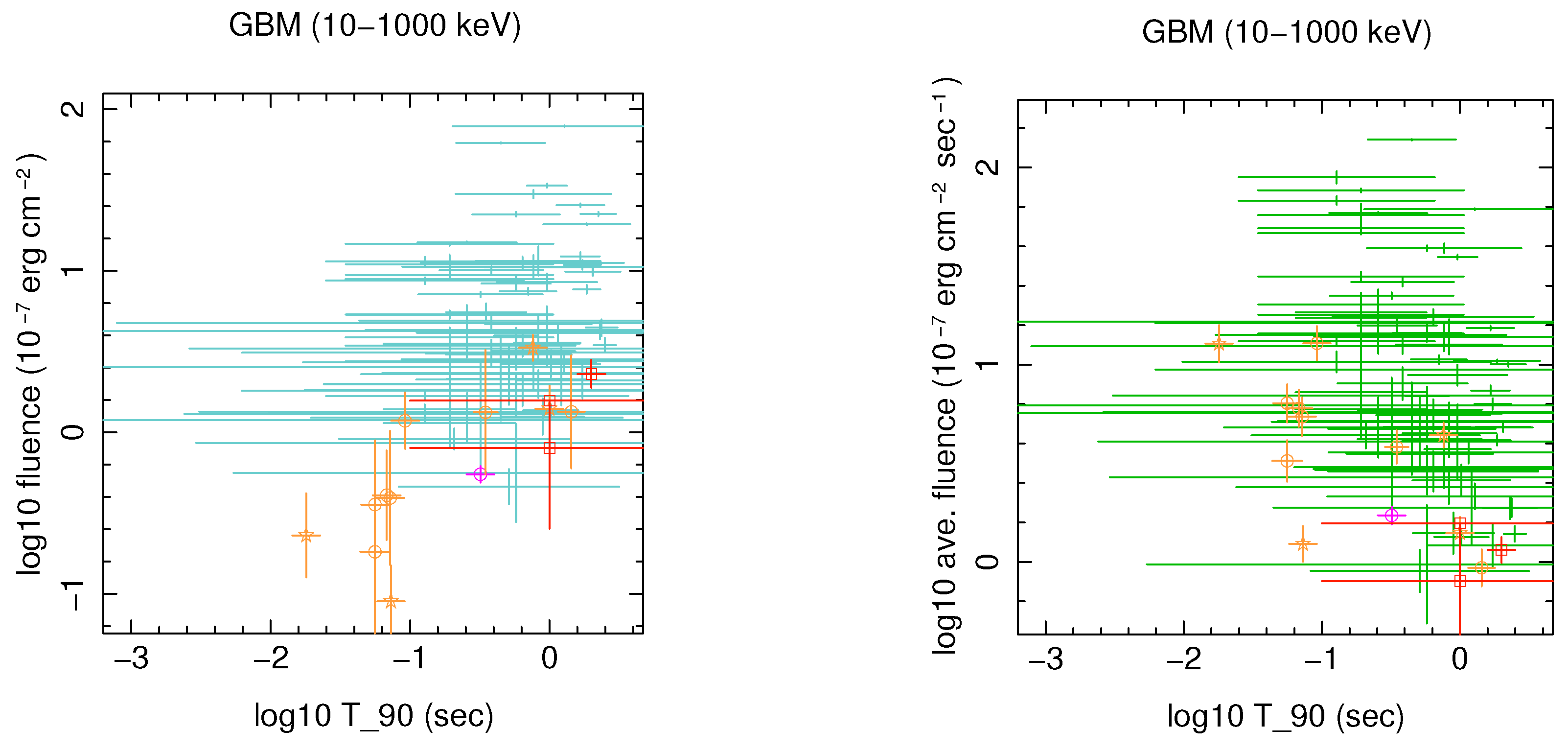

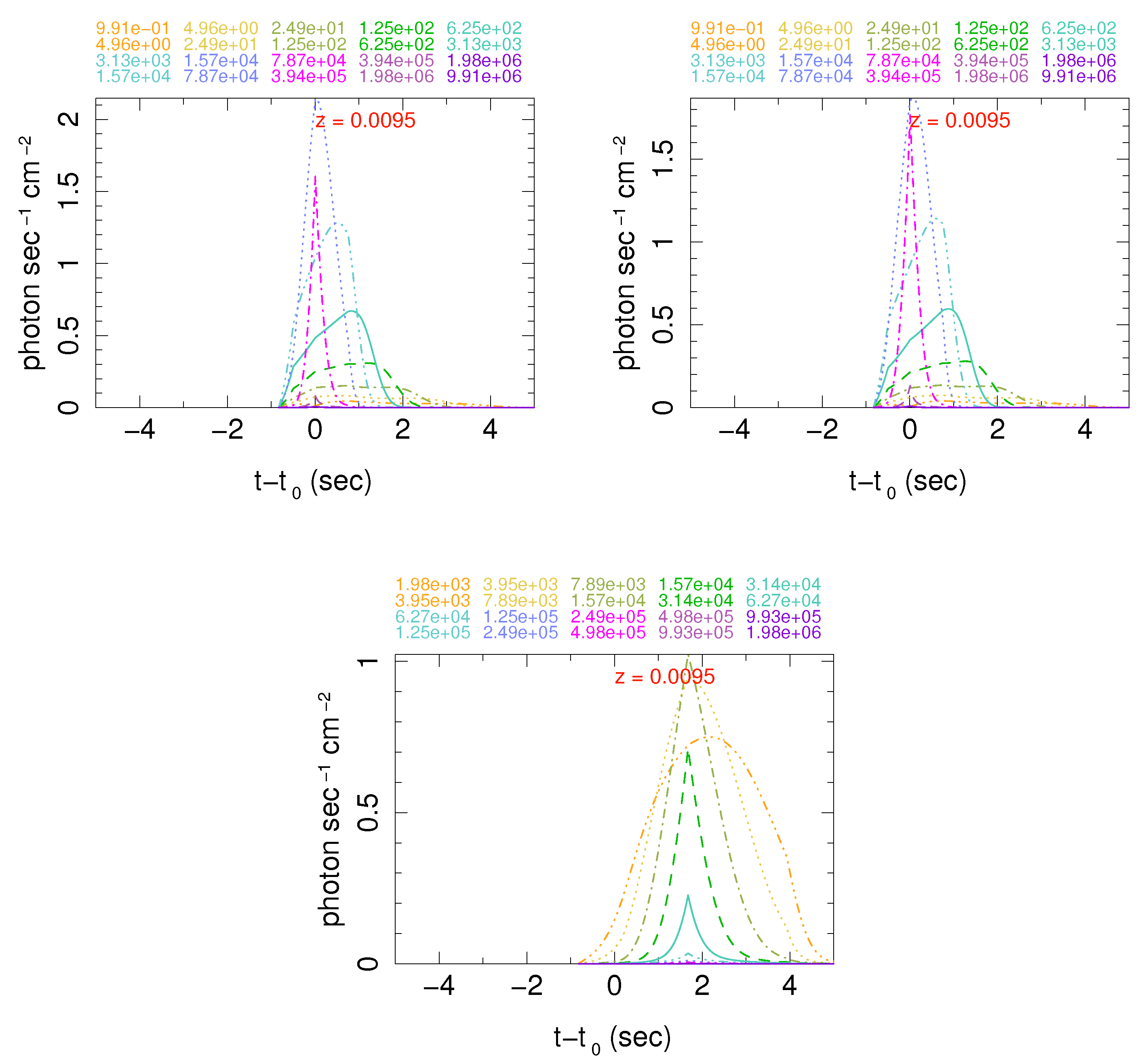
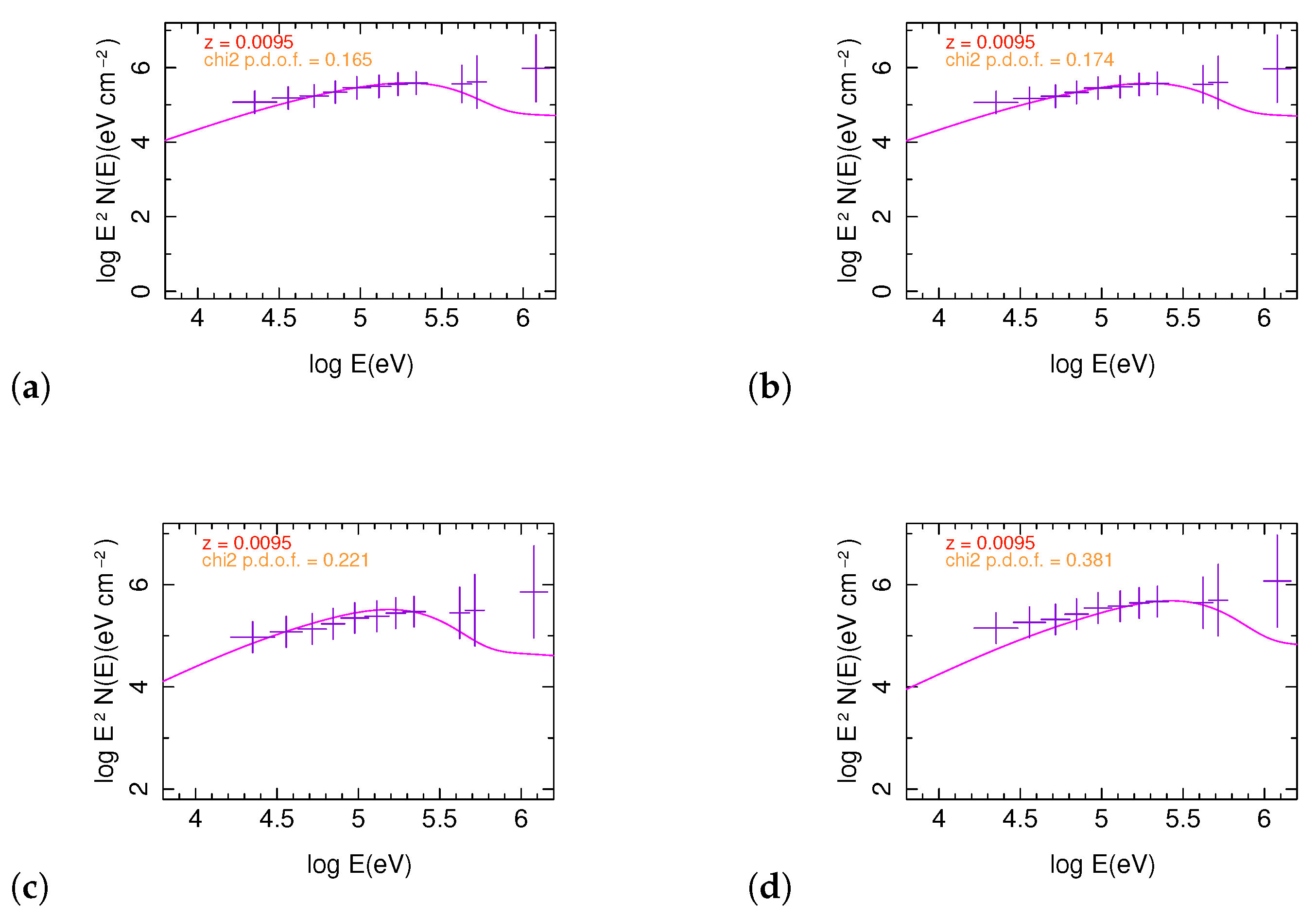
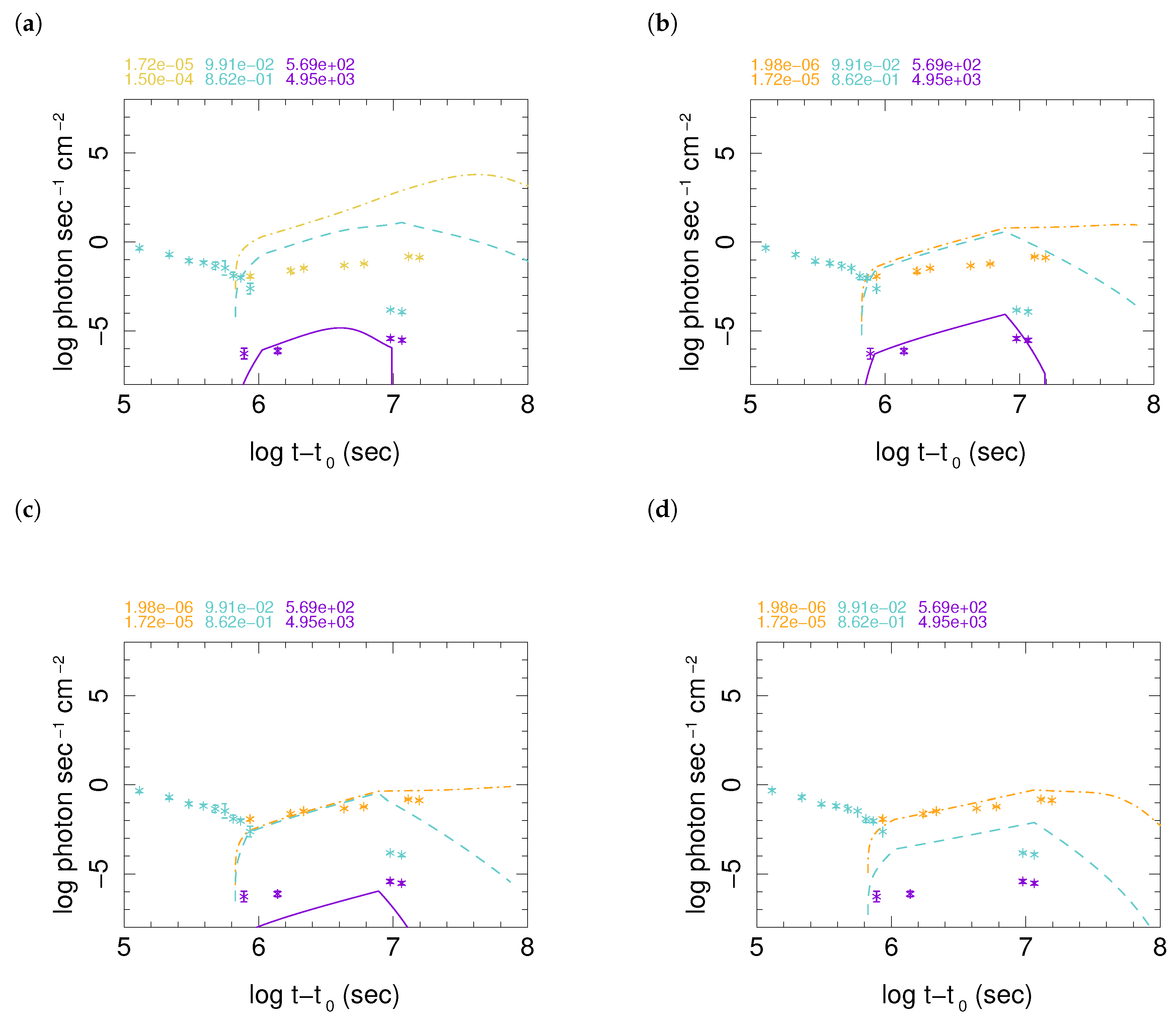
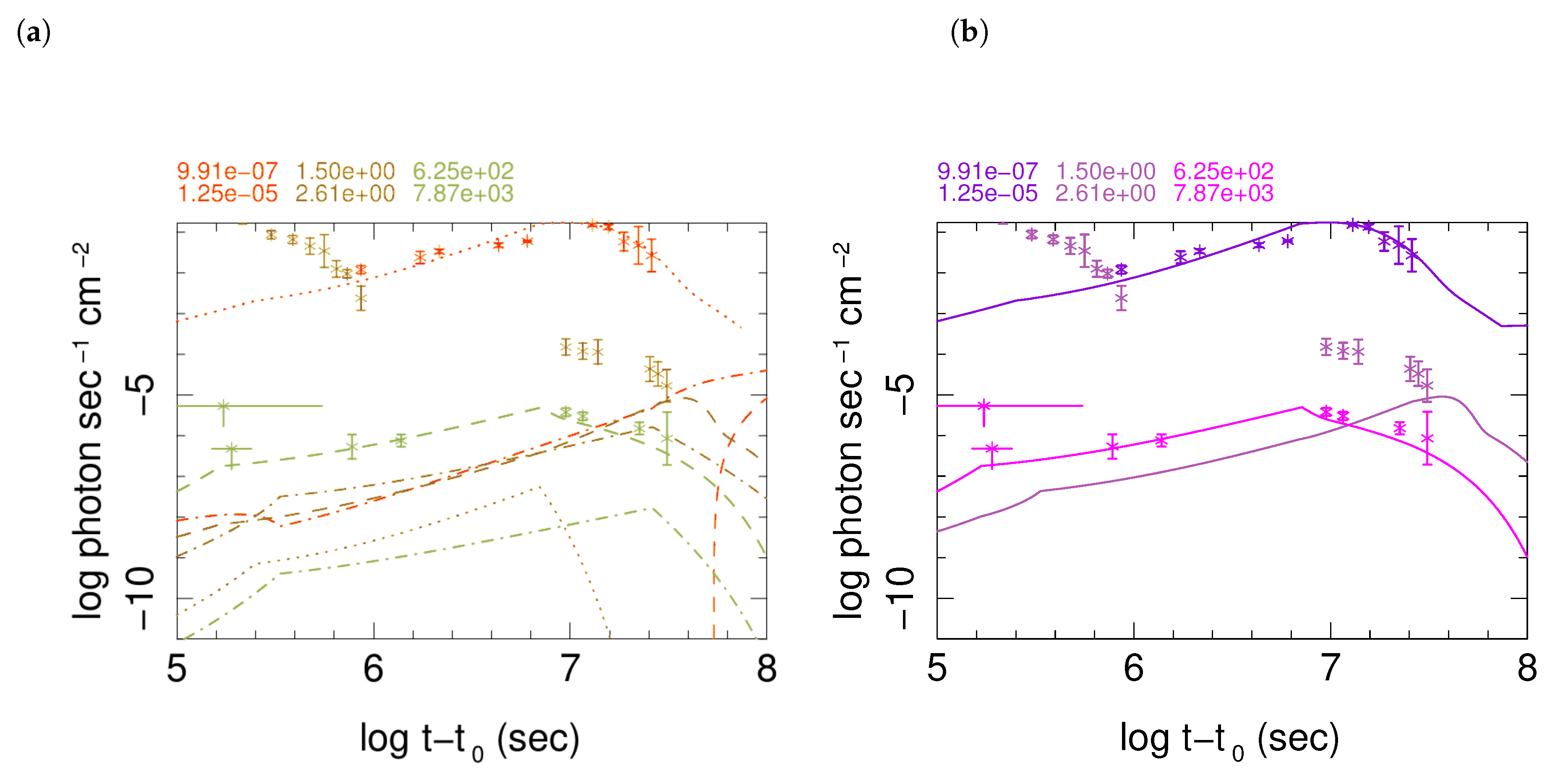
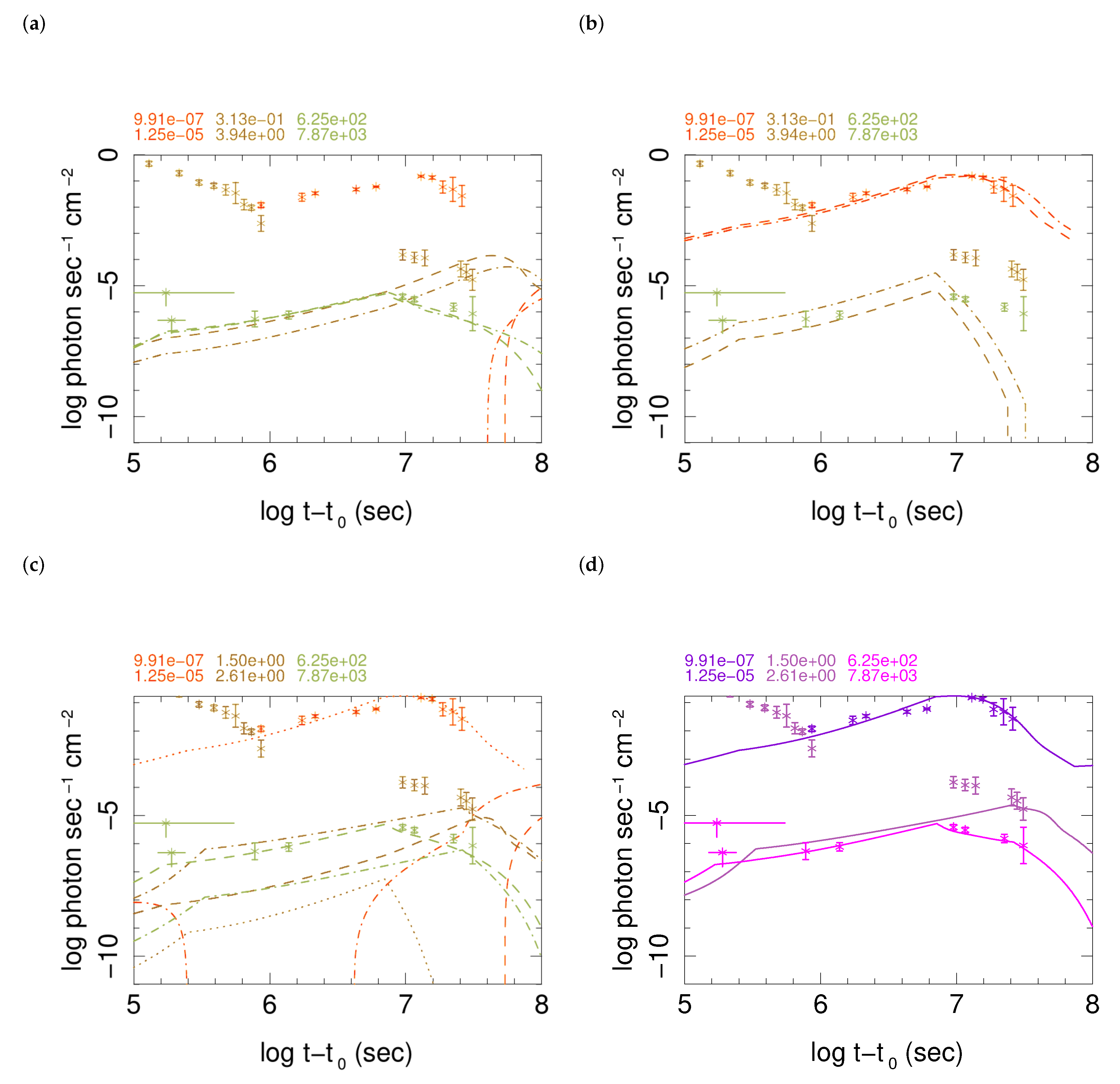
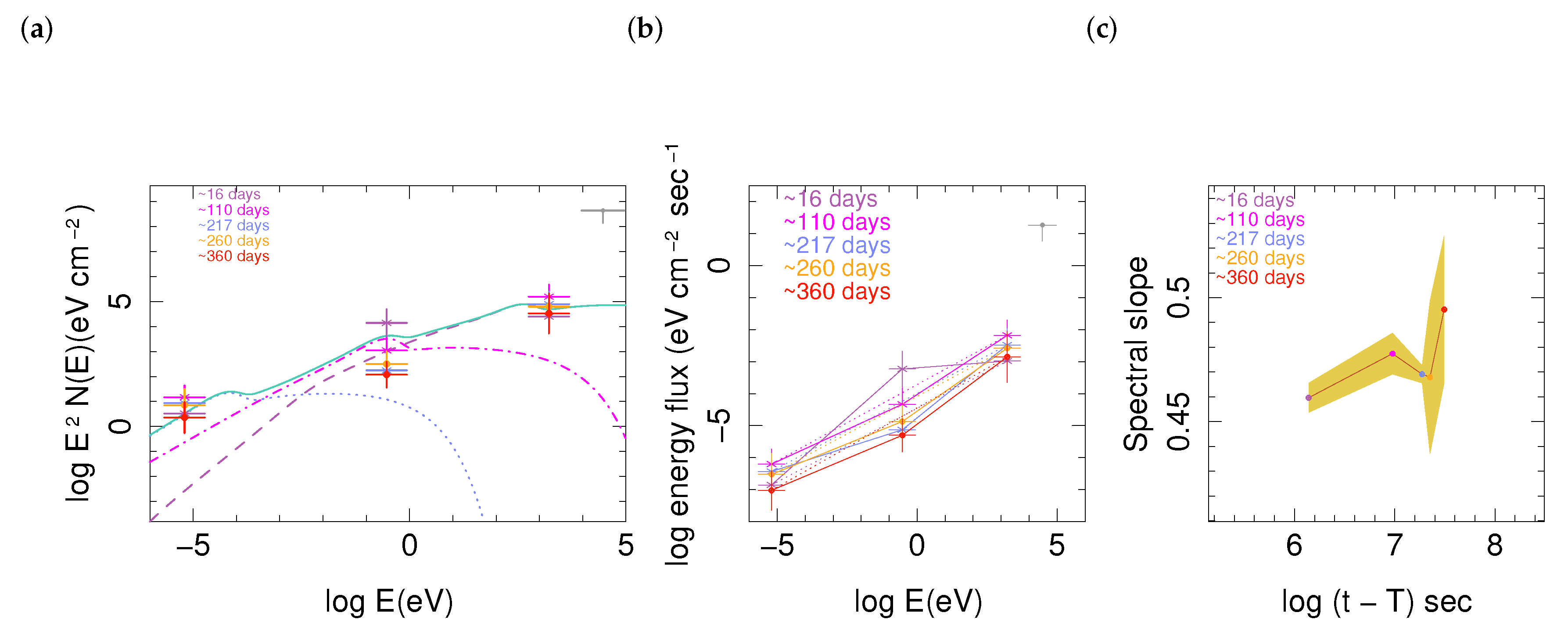
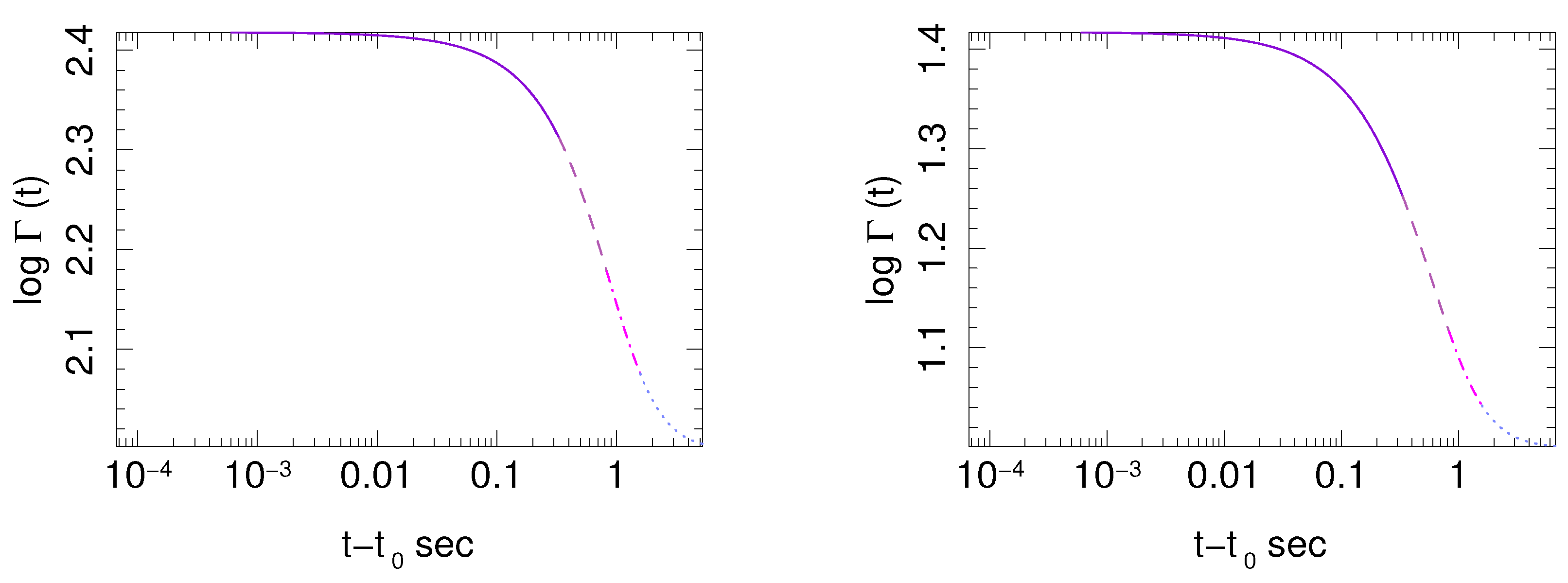

| Model Descr. | mod. | (cm) | p | ||||||||
|---|---|---|---|---|---|---|---|---|---|---|---|
| 1: GW/GRB 170817: first peak, rel.jet | 1 | 100 | 1.5 | 2.5 | 10 | 0 | 1.5 | - | 1 | ||
| 0 | - | - | - | 1.5 | - | 10 | 0 | - | 0 | - | |
| 2 | - | - | - | 1.5 | - | 10 | 0 | - | - | 3 | |
| 2 | - | - | - | 4 | - | 10 | 0 | - | - | 5 | |
| 2: GW/GRB 170817: first peak, off-axis | 1 | 10 | 1.5 | 2.5 | 10 | 0 | 1.5 | - | 1 | ||
| 0 | - | - | - | 1.5 | - | 10 | 0 | - | 0 | - | |
| 2 | - | - | - | 1.5 | - | 10 | 0 | - | - | 3 | |
| 2 | - | - | - | 4 | - | 10 | 0 | - | - | 5 | |
| 3: GW/GRB 170817: second peak | 1 | 30 | 1.5 | 2.5 | 10 | 0 | 1.5 | - | 1 | ||
| 0 | - | - | - | 1.5 | - | 10 | 0 | - | 0 | - | |
| 2 | - | - | - | 1.5 | - | 10 | 0 | - | - | 3 | |
| 2 | - | - | - | 4 | - | 10 | 0 | - | - | 5 | |
| Model Descr. | (cm) | (cm) | (kG) | (Hz) | (rad.) | ||||||
| 1: GW/GRB 170817: first peak, rel.jet | −1 | 0.01 | −1 | 0.8 | 500 | - | - | ||||
| - | −2 | - | -2 | - | - | - | - | 1 | - | ||
| - | 2 | - | 2 | - | - | - | - | 2 | - | ||
| - | 4 | - | 4 | - | - | - | - | 3 | - | ||
| 2: GW/GRB 170817: first peak, off-axis | -1 | 0.03 | −1 | 0.5 | 500 | 1 | - | ||||
| - | −2 | - | −2 | - | - | - | - | 1 | - | ||
| - | 2 | - | 2 | - | - | - | - | 2 | - | ||
| - | 4 | - | 4 | - | - | - | - | 3 | - | ||
| 3: GW/GRB 170817: second peak | −1 | 0.01 | −1 | 0 | - | - | - | ||||
| - | −2 | - | −2 | - | - | - | - | - | - | ||
| - | 2 | - | 2 | - | - | - | - | - | - | ||
| - | 4 | - | 4 | - | - | - | - | - | - |
| Comp. | mod. | (cm) | p | (cm) | (cm) | ||||||||||
|---|---|---|---|---|---|---|---|---|---|---|---|---|---|---|---|
| Ultra. rel. (C1) | 1 | 130 | 1.5 | 1.8 | 100 | −0.5 | 0.5 | −1 | 0.1 | −1 | |||||
| 2 | - | - | - | 15 | - | 100 | 0.3 | 0.1 | - | 0 | - | 0 | - | - | |
| 2 | - | - | - | 20 | - | 100 | 0.4 | 0.05 | - | 1 | - | 1 | - | - | |
| Rel. (C2) | 1 | 5 | 2 | 2.1 | 100 | −0.5 | 1 | −1 | 0.1 | −1 | |||||
| 2 | - | - | - | 40 | - | 100 | 0.4 | 0.1 | - | 0 | - | 0 | - | - | |
| 2 | - | - | - | 100 | - | 100 | 0.5 | 1 | - | 1 | - | 1 | - | - | |
| Mildly rel. (C3) | 1 | 1.06 | 1.5 | 1.8 | 100 | −0.5 | 1 | −1 | 0.02 | −1 | |||||
| 2 | - | - | - | 10 | - | 100 | 0. | 0.1 | - | 0 | - | 0 | - | - | |
| 2 | - | - | - | 10 | - | 100 | 1 | 1 | - | 1 | - | 1 | - | - |
© 2019 by the author. Licensee MDPI, Basel, Switzerland. This article is an open access article distributed under the terms and conditions of the Creative Commons Attribution (CC BY) license (http://creativecommons.org/licenses/by/4.0/).
Share and Cite
Ziaeepour, H. Binary Neutron Star (BNS) Merger: What We Learned from Relativistic Ejecta of GW/GRB 170817A. Physics 2019, 1, 194-228. https://doi.org/10.3390/physics1020018
Ziaeepour H. Binary Neutron Star (BNS) Merger: What We Learned from Relativistic Ejecta of GW/GRB 170817A. Physics. 2019; 1(2):194-228. https://doi.org/10.3390/physics1020018
Chicago/Turabian StyleZiaeepour, Houri. 2019. "Binary Neutron Star (BNS) Merger: What We Learned from Relativistic Ejecta of GW/GRB 170817A" Physics 1, no. 2: 194-228. https://doi.org/10.3390/physics1020018
APA StyleZiaeepour, H. (2019). Binary Neutron Star (BNS) Merger: What We Learned from Relativistic Ejecta of GW/GRB 170817A. Physics, 1(2), 194-228. https://doi.org/10.3390/physics1020018




